#source: mars.nasa.gov
Explore tagged Tumblr posts
Text
The different Mars Rovers and what we learned
Sojourner (1997)
First rover to successfully land on Mars. Defined by NASA as a "micro-rover" due to its small size, Sojourner had a speed of maximum of 0.4 meters pr. minute. It was active for about 80 days on the surface of Mars.
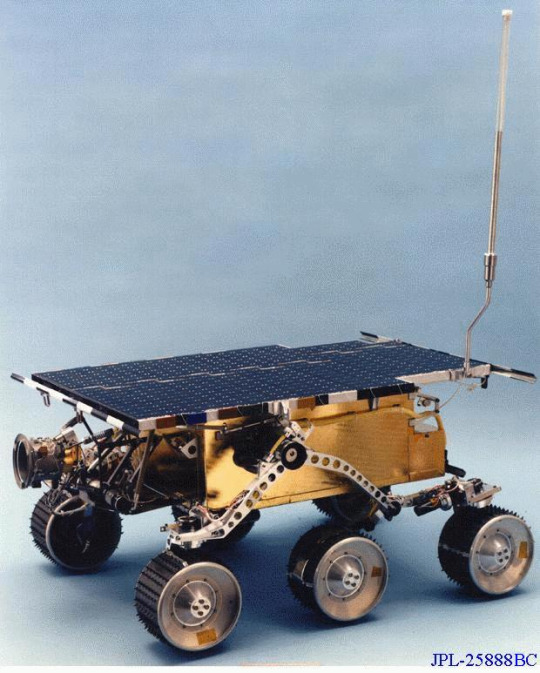
Sojourner carried three cameras, an Atmospheric Structure Instrument (Meteorology Package) and an Alpha Proton X-ray Spectrometer. There instruments.
From Sojourner, NASA learned about the surface and weather conditions of Mars.
Sojourner found rounded rocks at the landing site, which suggests that running water could have been on Mars. The radio-tracking of Pathfinder (mission name) also gave an estimate of Mars' metal core's size (1300 kilometers to 2000 kilometers). It also discovered that the dust that is in the air on Mars is magnetic and possibly made up of mahemite. Sojourner also observed dust devils, ice clouds in the lower atmosphere and temperature fluctuations on the surface of Mars.
Spirit (2004-2010) and Opportunity (2004-2018)
Spirit was one of two Mars rovers launched in 2003 (mission started in 2004). The wheels on Spirit and Opportunity were about double the size of Sojourners. The weight of both rovers was about 17 times Sojourners, and more than double the size. Their goal on Mars was to search the surface for traces of past water. In 2009, Spirit got stuck in soil (in the area called Troy). In 2010, Spirit stopped communications, and the mission ended in 2011.
Opportunity was launched in 2004 along with Spirit but lasted much longer than their twin. Setting the record for the longest-lasting Mars rover, Opportunity stopped communications in 2018. Opportunity also set the record for the longest distance traveled by a rover, around 45 kilometers.
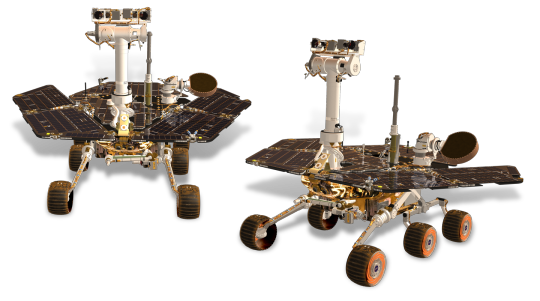
Like Sojourner, Spirit provided data about Mars' weather conditions, especially the wind. Both Spirit and Opportunity found evidence of possible conditions on Mars that could allow microbial life.
Spirit and Opportunity both had panoramic cameras, a thermal emission spectrometer, a Moessbauer spectrometer, an alpha particle X-ray spectrometer, and a microscopic imager.
Curiosity (2012-present)
Curiosity is currently the oldest active Mars rover (as of 21/07/2023) The main purpose of Curiosity is to figure out if Mars has the right environment for microbial lifeforms. Curiosity is currently exploring Gale Crater and had the most advanced instruments at the time. Curiosity has found evidence of water having been on Mars in the past, found old organic material, and discovered that Mars has had a thicker atmosphere in the past.
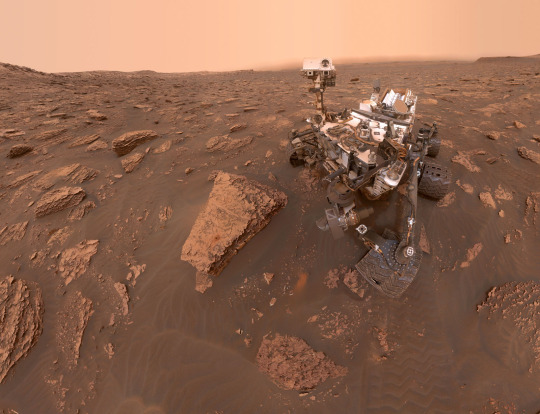
Curiosity can climb over knee-high obstacles and can go up to 30 meters per hour.
Curiosity carries a radioisotope power system to generate electricity, which gives the rover a steady electricity flow. Curiosity also carries 17 cameras, a laser, a drill, and 10 different instruments.
Perseverance (2021-present)
Perseverance is the newest Mars rover from NASA. The main goal for Perseverance is to research habitable conditions on Mars, but also for signs of past microbial life. The mission also tests possible options for future human expeditions on Mars (ex. improved landing techniques, producing oxygen from the atmosphere and environmental conditions).
The drill Perseverance used can collect samples and then set them aside for collection on the surface.
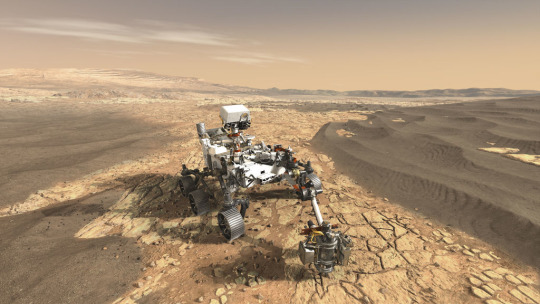
Zhurong (2021-2022)
Launched by the CNSA, Zhurong is the first Chinese Mars rover. In 2022 it became inactive due to sandstorms and the winter, which prevented it from waking at an appropriate temperature and good sunlight conditions.
Zhurong's mission was to study the topography, examine the surface (soil and elements), and take samples of the atmosphere. To do this it had a RoPeR (Mars Rover Penetrating Radar), RoMAG (Mars Rover Magnetometer), MCS (Mars Climate Station), MarSCoDE (Mars Surface Compound Detector), a multispectral camera and navigation and topography cameras. It also had a remote camera on board.

#astronomy#mars rover#sojourner#spirit#opportunity#curiosity#perseverance#zhurong#nasa#source: mars.nasa.gov#source:wikipedia#mainly for zhurong
54 notes
·
View notes
Text
Ancient Alien Face On Mars Rover Photo, June 19, 2024, UFO Sighting News.
NASA Source photo: https://mars.nasa.gov/mars2020/multimedia/raw-images/ZR0_1175_0771255885_081EBY_N0530000ZCAM09211_0630LMJ
Guys I found this amazing face in a Mars rover photo that just came out this week. The face looks very human, two eyes, nose, ears, chin, cheeks, lips...but as you look at the forehead, you see five cranium ridges that go very high. This alien had a very high forehead compared to us. Just wanted to share it with you. Please remember to subscribe for more, thank you.
Scott C. Waring
0 notes
Photo

2021 September 14
Mars Panorama 360 from Curiosity Image Credit: NASA, JPL-Caltech, MSSS; Processing & License: Elisabetta Bonora & Marco Faccin (aliveuniverse.today)
Explanation: Which way up Mount Sharp? In early September, the robotic rover Curiosity continued its ascent up the central peak of Gale Crater, searching for more clues about ancient water and further evidence that Mars could once have been capable of supporting life. On this recent Martian morning, before exploratory drilling, the rolling rover took this 360-degree panorama, in part to help Curiosity's human team back on Earth access the landscape and chart possible future routes. In the horizontally-compressed featured image, an amazing vista across Mars was captured, complete with layered hills, red rocky ground, gray drifting sand, and a dusty atmosphere. The hill just left of center has been dubbed Maria Gordon Notch in honor of a famous Scottish geologist. The current plan is to direct Curiosity to approach, study, and pass just to the right of Gordon Notch on its exploratory trek.
∞ Source: apod.nasa.gov/apod/ap210914.html
46 notes
·
View notes
Photo

Interplanetary Geocache Point The Perseverance Rover carries this piece with it as part of its calibration target, including the first ever interplanetary geocaching tracker. This image was returned yesterday from the Watson camera on that rover, and so far over 25,000 geocaching logs have already been registered. -JBB Image source: https://mars.nasa.gov/mars2020/multimedia/raw-images/SI1_0026_0669253775_136ECM_N0030792SRLC07004_0000LUJ
#Science#space#mars#perseverance#rover#geocaching#geocache#travel#the universe#the real universe#isuniverse
44 notes
·
View notes
Photo

Follow our 2nd page @spacemisson This image was taken by Mast Camera (Mastcam) onboard NASA's Mars rover Curiosity on Sol 1283 (2016-03-16 07:57:16 UTC). Image Credit: NASA/JPL-Caltech/MSSS Image source: https://mars.nasa.gov/msl-raw-images/msss/01283/mcam/1283MR0060320060304322E01_DXXX.jpg 👉HD Video Link in Bio Follow 👉 @marsmisson For More Update #spacetravel #nasa #astronomy #cosmos #universe #science #space #iss #galaxy #planet #astronaut #mars #mars2020 #rocketscience #falcon9 #spacex #LaunchAmerica #atlasV #CountdownToMars #rocket #cosmonaut #perseverance #curiosity #exoplanet #robotics #astrobiology #spaceexploration #marsrover #helicopter #perseverance #marsrover #marshelicopter (at United States) https://www.instagram.com/p/CYCN_HtMeEa/?utm_medium=tumblr
#spacetravel#nasa#astronomy#cosmos#universe#science#space#iss#galaxy#planet#astronaut#mars#mars2020#rocketscience#falcon9#spacex#launchamerica#atlasv#countdowntomars#rocket#cosmonaut#perseverance#curiosity#exoplanet#robotics#astrobiology#spaceexploration#marsrover#helicopter#marshelicopter
2 notes
·
View notes
Text
The Mars Oxygen In-Situ Resource Utilization Experiment is better known as MOXIE. NASA is preparing for human exploration of Mars, and MOXIE will demonstrate a way that future explorers might produce oxygen from the Martian atmosphere for propellant and for breathing.
5 Things to Know:
1. MOXIE Makes Oxygen on Mars
Carbon dioxide makes up ~96% of the gas in Mars' atmosphere. Oxygen is only 0.13%, compared to 21% in Earth's atmosphere.
2. MOXIE Is a Test Model
MOXIE is the size of a car battery. Future oxygen generators that support human missions on Mars must be about 100 times larger.
3. MOXIE Helps Future Explorers
To launch off of Mars, human explorers need about 33 to 50 tons (30 to 45 metric tons) of fuel, about the weight of a Space Shuttle.
4. MOXIE Breathes like a Tree
MOXIE makes oxygen like a tree does. It inhales carbon dioxide and exhales oxygen.
5. Homemade on Mars
Homemade liquid oxygen on Mars could supply more than ¾ of the propellant humans need for exploration on the Red Planet.
Source: mars.nasa.gov
💬 Do you want to visit Mars when it becomes habitable?
🌏 Follow (@worldoffactsnow) and Turn on Notification & never miss our post!



#mars#mars rover#mars 2021#mars mission#mars2020#nasa#space news#oxygen#science#perceverance#facts#fun facts#trivia#facts on facts#facts of life#did you know#history#fact
14 notes
·
View notes
Photo

Screen based narrative analysis
As the narrative is based on real locations in the solar system, it is a digital recreation of real places. This part of the research is therefore very helpful in analysing the core concept of the film, which is to understand the solar system and to demonstrate the possibilities offered by technological advancements.
Plot Point 1
The first act shows humans in the future realising the technology of astronautics and coming to Jupiter to explore the Great Red Spot and Saturn's rings

The Great Red Spot

This image is from Jupiter's Great Red Spotfrom Voyager 1 (1979)
The Great Red Spot as seen from Voyager 1. This dramatic view of Jupiter's Great Red Spot and its surroundings was obtained by Voyager 1 on February 25, 1979, when the spacecraft was 5.7 million miles (9.2 million kilometers) from Jupiter.
Reference: https://photojournal.jpl.nasa.gov/catalog/PIA00014

Ring of Saturn
One scene gives an extreme close-up view of Saturn's rings - the angle of view is from inside the ring plane, looking up through the chaotic water ice that makes up the rings, with one of the astronauts floating above the plane.

The original source for the images depicted in the film is NASA / ESA Cassini-Huygens on October 15, 1997 , and a third of the scenes depict Saturn or one of its moons, including a wealth of data and images.
Reference: https://en.wikipedia.org/wiki/Cassini%E2%80%93Huygens
Plot Point 2
The viewpoint travels to Mars, where CGI technology reveals an imaginary space lift and the establishment of a colonisation base on Mars, where travellers travel this planet and enjoy the 'blue' sun.

Space elevator on Mars

Exploring and travelling on Mars (Victorian impact crater)

Victoria Crater as seen by the NASA rover Opportunity (MER-B) in 2006
Reference:https://photojournal.jpl.nasa.gov/catalog/PIA09104

The 'blue' sun

This photo taken by NASA's Spirit (rover) on May 19th, 2005 on Mars to create the "Blue Sunset" scene in the film
Rference: https://mars.nasa.gov/mer/gallery/press/spirit/20050610a.html
Plot Point 3
The film shows the transformed asteroids and moons in this scene, depicted as a hollowed out asteroid that could serve as a habitat for colonists, with an internal cavity consisting of a human-built, self-sustaining ecosystem.

The base on The equator of Iapetus

Taken on September 10, 2007 at a distance of 62,331 km (38,731 mi) Iapetus's equatorial ridge
Reference:https://en.wikipedia.org/wiki/Cassini%E2%80%93Huygens

Establishing settlements on Saturn's moons

As it entered the Saturn system, NASA's Cassini spacecraft performed its first targeted flyby of one of the planet's moons. On June 11, 2004, Cassini passed Phoebe, the largest of Saturn's outer or "irregular" moons, at an altitude of just 1,285 miles (2,068 kilometers).
Reference:https://photojournal.jpl.nasa.gov/catalog/PIA09104

A hollowed out asteroid

This concept from the NASA Ames Research Center
Reference:http://lifesci3.arc.nasa.gov/SpaceSettlement/70sArt/art.html
Plot Point 4
Humans could travel on these asteroids and moons and experience flight and low gravity.

Adventurers crossing the surface ice on Jupiter's moon Europa


Because Titan's atmosphere is thicker and less gravitational than Earth's, humans experience flying here

The film shows adventurers wearing bird-like wings flying over the liquid methane lake Ligeia Mare on Saturn's moon Titan.
Reference:https://photojournal.jpl.nasa.gov/catalog/PIA17031

Tourists and adventurers jump off the cliffs of Miranda, the smallest moon orbiting Uranus.
Due to Miranda's low gravity, it takes 12 minutes to reach the surface after jumping off the cliff, allowing travellers to experience low gravity
Plot Point 5
Finally, the film ends with a magnificent view of Saturn's rings through the eyes of future travelers!

Saturn's rings


Real data about Saturn's rings taken on December 12, 2004 by NASA
Reference:https://photojournal.jpl.nasa.gov/catalog/PIA07874
2 notes
·
View notes
Text




Images from Perseverance’s hazard avoidance cameras, taken at 3:37 pm local solar time on mission sol 2 (Feb. 21)
Image source: https://mars.nasa.gov/mars2020/multimedia/raw-images/
More info in the notes
3 notes
·
View notes
Video
youtube
CG NEWS # 43 iPi Soft | Unity | Maya 2022 | KeenTools | Corona Renderer 7 | NFT Cryptoart
In this issue:
- Maya 2022 update. - @iPiSoft released plugin for @Unreal Engine - FaceBuilder by @KeenTools kicks a face in a photo using neural networks. - A new level of open source. Developer @Blender Developers is streaming bug fixes.
#nftartist:
Cover - Denerog - https://twitter.com/Denerog1
ArkadiyGrigoryants - https://twitter.com/ArkadiyGrigory3
Dreddnova - https://twitter.com/Dreddnova
Egor Golopolosov - https://twitter.com/EGolopolosov
Daria Prostova - https://twitter.com/otkudanebo
LASTNIGHT - https://twitter.com/chtozaparen
Sources:
iPi Soft launched a plugin for Unreal Engine - https://www.ipisoft.com
Maya 2022 - https://help.autodesk.com/view/MAYAUL...
3ds Max 2022 - https://help.autodesk.com/view/3DSMAX...
KeenTools 2021.2 - https://keentools.io/
Unity 2020 LTS и Unity 2021.1 Tech Stream - https://blogs.unity3d.com/ru/2021/03/...
Developer streams Blender - https://www.youtube.com/BlenderDevelo...
PBR Material в Corona Renderer 7 - https://blog.corona-renderer.com/behi...
Reallusion Character Creator 3.4 - https://www.reallusion.com/character-...
Reallusion iClone 7.9 - https://www.reallusion.com/iclone/3d-...
Howler 2021.4 - http://www.pdhowler.com/WhatsNew.htm
Free parallax textures wParallax - https://gumroad.com/l/YyRmU
Free photorealistic materials on Adobe Substance Source - https://source.substance3d.com/allass...
Armor Paint - https://armorpaint.org/download.html
Plasmo turns a sketch into a 3D model - plasmo.ai
Send name to Mars - https://mars.nasa.gov/participate/sen...
Generator of paintings in style Beeple - http://beeplegenerator.com
2 notes
·
View notes
Photo

Original Panorama from the thing making the rounds from the Curiosity Rover
Northern Portion of Gale Crater Rim Viewed from 'Naukluft Plateau'
January 04, 2016
Source: https://mars.nasa.gov/resources/24599/northern-portion-of-gale-crater-rim-viewed-from-naukluft-plateau/?site=msl
1 note
·
View note
Text
Oxygen ... ?
Well, this is a little odd.
https://mars.nasa.gov/news/8548/with-mars-methane-mystery-unsolved-curiosity-serves-scientists-a-new-one-oxygen/?site=msl
The Curiosity rover has returned another very odd result from Mars. The short of it is that the small amount of oxygen in the Martian atmosphere varies seasonally. By itself, that’s probably not an enormous surprise - but the really odd bit is that it tracks with the annual methane variations. (If anything, I guess, you’d expect the opposite because methane, uh, interacts very favourably with free oxygen! You know, like literally being on fire and all that. So naively, you’d expect that an increase in one gas would actually cause a fall-off in the concentration of the other, as there’s more to react with.)
It’s worth noting that the proportion of free oxygen in Mars’s atmosphere is very small - 0.16%, versus about 20.5% on Earth. Still, actually, that 0.16% is higher than I would have expected - the only source that I can think of for oxygen on Mars would be photodiassociation of carbon dioxide by solar UV, and that would be a fairly minimal process.
So yeah, this is somewhat puzzling.
12 notes
·
View notes
Text
Curiosity Detects Unusually High Methane Levels
NASA - Mars Science Laboratory (MSL) logo. June 24, 2019
Image above: This image was taken by the left Navcam on NASA's Curiosity Mars rover on June 18, 2019, the 2,440th Martian day, or sol, of the mission. It shows part of "Teal Ridge," which the rover has been studying within a region called the "clay-bearing unit." Image Credits: NASA/JPL-Caltech. This week, NASA's Curiosity Mars rover found a surprising result: the largest amount of methane ever measured during the mission - about 21 parts per billion units by volume (ppbv). One ppbv means that if you take a volume of air on Mars, one billionth of the volume of air is methane. The finding came from the rover's Sample Analysis at Mars (SAM) tunable laser spectrometer. It's exciting because microbial life is an important source of methane on Earth, but methane can also be created through interactions between rocks and water. Curiosity doesn't have instruments that can definitively say what the source of the methane is, or even if it's coming from a local source within Gale Crater or elsewhere on the planet. "With our current measurements, we have no way of telling if the methane source is biology or geology, or even ancient or modern," said SAM Principal Investigator Paul Mahaffy of NASA's Goddard Spaceflight Center in Greenbelt, Maryland. The Curiosity team has detected methane many times over the course of the mission. Previous papers have documented how background levels of the gas seem to rise and fall seasonally. They've also noted sudden spikes of methane, but the science team knows very little about how long these transient plumes last or why they're different from the seasonal patterns. The SAM team organized a different experiment for this weekend to gather more information on what might be a transient plume. Whatever they find - even if it's an absence of methane - will add context to the recent measurement.
Mars Science Laboratory (MSL) or Curiosity rover. Animation Credits: NASA/JPL
Curiosity's scientists need time to analyze these clues and conduct many more methane observations. They also need time to collaborate with other science teams, including those with the European Space Agency's Trace Gas Orbiter, which has been in its science orbit for a little over a year without detecting any methane. Combining observations from the surface and from orbit could help scientists locate sources of the gas on the planet and understand how long it lasts in the Martian atmosphere. That might explain why the Trace Gas Orbiter's and Curiosity's methane observations have been so different. Related article: NASA Finds Ancient Organic Material, Mysterious Methane on Mars https://orbiterchspacenews.blogspot.com/2018/06/nasa-finds-ancient-organic-material.html For more information about Curiosity, visit: https://www.nasa.gov/mission_pages/msl/index.html https://mars.nasa.gov/msl/ Image (mentioned), Animation (mentioned), Text, Credits: NASA/Alana Johnson/JPL/Andrew Good. Greetings, Orbiter.ch Full article
28 notes
·
View notes
Text
Plant Grows From Rock On Latest Mars Photo! UFO Sighting News. Video, please subscribe to my channel for more.
Date of discovery: April 5, 2023
Location of discovery: Mars
Source photo: https://mars.nasa.gov/mars2020/multimedia/raw-images/ZR0_0754_0733878091_081EBY_N0371798ZCAM08760_1100LMJ
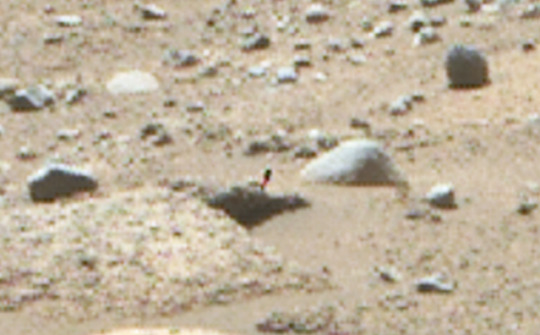
I found this pink and green plant growing from a rock on Mars, its one of the latest Mars Perseverance rover photos so its 100% news stuff. I have reported a white rose on Mars I found back in 2020, but this one being two colors and close up is just mind-blowing. Now you know why NASA puts most photos into false-color. To hide the truth from the public. 100% proof that life exists on planet Mars right now!
youtube
Scott C. Waring - Taiwan
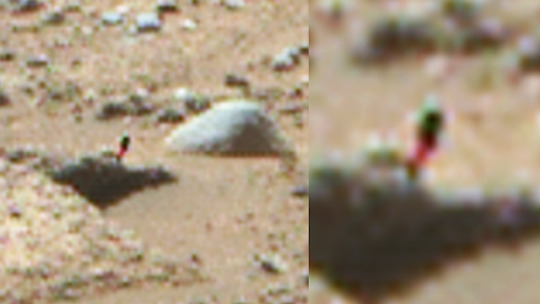
3 notes
·
View notes
Photo

2021 May 24
Lightning Eclipse from the Planet of the Goats Image Credit & Copyright: Chris Kotsiopoulos (GreekSky)
Explanation: Thunderstorms almost spoiled this view of the spectacular 2011 June 15 total lunar eclipse. Instead, storm clouds parted for 10 minutes during the total eclipse phase and lightning bolts contributed to the dramatic sky. Captured with a 30-second exposure the scene also inspired one of the more memorable titles (thanks to the astrophotographer) in APOD's now 25-year history. Of course, the lightning reference clearly makes sense, and the shadow play of the dark lunar eclipse was widely viewed across planet Earth in Europe, Africa, Asia, and Australia. The picture itself, however, was shot from the Greek island of Ikaria at Pezi. That area is known as "the planet of the goats" because of the rough terrain and strange looking rocks. The next total lunar eclipse will occur on Wednesday.
∞ Source: apod.nasa.gov/apod/ap210524.html
62 notes
·
View notes
Photo

This image was taken by the left Navcam on NASA's Curiosity Mars rover on June 18, 2019, the 2,440th Martian day, or sol, of the mission. It shows part of "Teal Ridge," which the rover has been studying within a region called the "clay-bearing unit."Credit: NASA/JPL-Caltech
This week, NASA's Curiosity Mars rover found a surprising result: the largest amount of methane ever measured during the mission - about 21 parts per billion units by volume (ppbv). One ppbv means that if you take a volume of air on Mars, one billionth of the volume of air is methane.
The finding came from the rover's Sample Analysis at Mars (SAM) tunable laser spectrometer. It's exciting because microbial life is an important source of methane on Earth, but methane can also be created through interactions between rocks and water.
Curiosity doesn't have instruments that can definitively say what the source of the methane is, or even if it's coming from a local source within Gale Crater or elsewhere on the planet.
"With our current measurements, we have no way of telling if the methane source is biology or geology, or even ancient or modern," said SAM Principal Investigator Paul Mahaffy of NASA's Goddard Spaceflight Center in Greenbelt, Maryland.
The Curiosity team has detected methane many times over the course of the mission. Previous papers have documented how background levels of the gas seem to rise and fall seasonally. They've also noted sudden spikes of methane, but the science team knows very little about how long these transient plumes last or why they're different from the seasonal patterns.
The SAM team organized a different experiment for this weekend to gather more information on what might be a transient plume. Whatever they find - even if it's an absence of methane - will add context to the recent measurement.
Curiosity's scientists need time to analyze these clues and conduct many more methane observations. They also need time to collaborate with other science teams, including those with the European Space Agency's Trace Gas Orbiter, which has been in its science orbit for a little over a year without detecting any methane. Combining observations from the surface and from orbit could help scientists locate sources of the gas on the planet and understand how long it lasts in the Martian atmosphere. That might explain why the Trace Gas Orbiter's and Curiosity's methane observations have been so different.
For more information about Curiosity, visit:
https://www.nasa.gov/mission_pages/msl/index.html
https://mars.nasa.gov/msl/
22 notes
·
View notes
Text
Send Your Name To Mars

Everyone's dream to see to shine their name on sky but in real world it is not possible for all but now NASA try to shine your name on Mars. Yes, if you wants to see to shine your name on star then NASA gives you a golden opportunity. It is not possible for you to visit Mars but NASA try to visit your name to mars. I am talking about NASA new Mars mission which may be launch on next year. NASA invites you to send your name to rover who will go to mars.
In 2020, NASA plan to visit their one of his rover to mars which may be launch on next year in summer and probably lands before February, 21. However it is very strange to see that NASA not mentioning or reveals rover name but some sources said it is the sequal or part 2 of curiosity due to its design which is same like curiosity but its technology is upgraded.
Super cane and mast cane jet cameras are used for this rover which contains 3d features as well as zoom capability. This rover is launch in b/w July,17 to August,5 from Cape Air force station , fluoride. The main purpose of this rover to know about the river delta, study of zoology ,finds life, finds water ice. NASA design a device on this rover which try to covert carbon dioxide into oxygen which makes this rover attractive if this device works successfully then definitely one day humans lands on mars.
NASA also try to visit your name to mars with the help of microchip which contains your name. These names is inserted in microchip with the help of electron beam . Microchip is inserted on rover which contains your name. You need to fill a online form whose link is given below after that you get a boarding pass in which your name is print.
https://mars.nasa.gov/participate/send-your-name/mars2020
Comments
1 note
·
View note